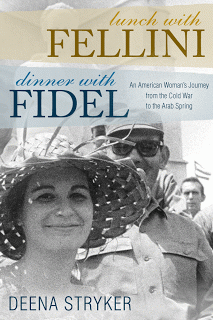
Book cover of Deena Stryker's autobiography, Lunch with Fellini, Dinner with Fidel
(Image by Denna Stryker) Details DMCA
This review is from: Lunch with Fellini, Dinner with Fidel: An Illustrated Personal Journey from the Cold War to the Arab Spring (Amazon Paperback)
The overriding sensation in reading Deena Stryker's amazing autobiography, Lunch with Fellini, Dinner with Fidel, is one of pinching yourself,
Can this all be true?
Why isn't she well known, on TV and in the press?
The answer to the first question is a resounding yes. Ms. Stryker's Fellini-Fidel is simply too good of a yarn to be made up. For the second question, I think I have the answer to that one. Read on.
Not many American children get to take off on a steamship at the age of 14 to live in Europe, but this experience is the cultural and political launching pad that sets into orbit her incredible life story. If you are keeping count, she doesn't come back to live in the United States for another 24 years. It is during this nearly two and half decades that the bulk of her autobiography takes place, in what some would say, is her fairy tale life of adolescence and early adulthood.
First though, she critically introduces us to her early upbringing. Reading about Ms. Stryker's childhood only confirms in my mind the belief that almost all of us have conflicted first years and grow up in what armchair and professional psychologists like to call dysfunctional families. We can forget about Leave It to Beaver and Father Knows Best, and like the rest of us, hers was reality based. Case in point: a larger than life, fearful, domineering father, an aloof, emotionally detached mother and the usual travails and misgivings of less than ideal stepparents. Ms. Stryker convincingly shows how her early life helped mold and define her emotionally and spiritually. These themes, with the specter and memory of her maternal grandmother in the background, are the fateful lubrication for many of Deena Stryker's decisions, which help to make her life story such a riveting one.
Using literary themes of a book, we can say that her childhood sets the mood of the story throughout. Furthermore, her family members, like for so many of us, necessarily and often play the roles of antagonists, which is thus the case in Fellini-Fidel's engrossing plot. They keep coming back throughout the book, either in person or in memory, to create many of the story's conflicts. Needless to say, Ms. Stryker plays to perfection the leading role of protagonist and there are other white hats who join her, to help round out the story.
(Note: You can view every article as one long page if you sign up as an Advocate Member, or higher).




